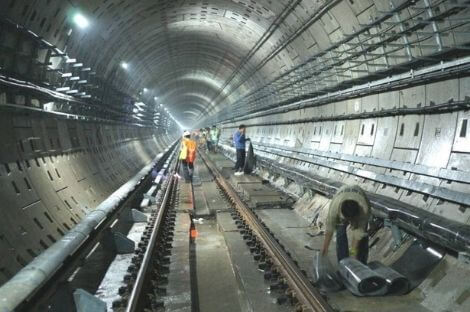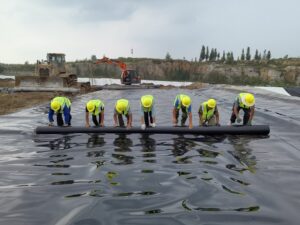Generally speaking, drainage solutions always play an essential role in a tunnel construction project. Although there are lots of difficulties in the whole process of construction, Shareholders need to ensure that the proper drainage and waterproofing plan is implemented by not only the contractor but also by everyone in the design and installation process. In a word, most waterproof and drainage projects related to tunnel construction should take the principle of “drainage and blocking” and adopt featured solutions for local hydrogeological conditions.
What Is A Drainage System?
A drainage system is a mechanism to remove liquids away from where they are not required for disposal in proper locations. This system can collect anything from drains to remove rain or stormwater to drain the water. To accomplish the whole procedure, high-quality drainage materials and systems should be applied to the anti-seepage project of tunnel construction.
Drainage boards, also known as Dimple Sheets or Drainage Sheets, are usually transported to the tunnel by a car or truck and laid in the tunnel, wrapped outside the tunnel, and welded into large pieces using a “nail-free” craft.
4 Tips To Establish A Good Drainage System With Drainage Boards
1. Design and Install A Waterproof and Drainage Layer
Before the installation of the waterproof layer, the exposed bolt head that initially supports the drainage board surface should be cut and wrapped with mortar. After smoothing the uneven part with mortar, non-woven geotextiles(also known as non-woven fabrics) and dimple sheets will be fixed from the arch lining towards both sides of the tunnel. Moreover, geotextiles shall be fixed with cement nails and PVC gaskets in advance while drainage sheets can be welded firmly to the gaskets by hot air welding machines.
Some Know-how(s):
- When fixing the drainage board, a certain margin should be reserved according to the flatness of the spray anchor that supports the surface to prevent it from being squeezed by the concrete because of the over-tightening status.
- To make the joints of drainage sheets well welded, the length of every drainage board should be 0.5-1.0 meters longer than that of the lining to facilitate joint welding construction.
- The constructing joint of the drainage board and lining should be staggered by 0.5-1.0 meters.
- After dimple sheets are paved, the concrete should be cast in place as soon as possible.
- When the concrete lining of the soft rock section closely covers the excavation surface, protective measures shall be taken to reserve the joint of the dimple sheet at the end of the lining to prevent flying stones from damaging the drainage board.
2. Proper Measures For Soft Permeable Pipe Blind Ditch
The reserved length of the pipe joint should be considered when processing and cutting the flexible permeable pipe to ensure that both ends of the annular blind pipe can fully enter the longitudinal blind ditch. Permeable pipes need to closely contact the shotcrete surface while a certain degree of looseness must be guaranteed, and should not be overly stretched. In the meantime, exposed anchors that fix permeable pipes should be cut or smoothed with mortar to prevent puncturing the drainage board. All in all, to prevent water leakage and damage to the pipe joints, they should be well-treated during construction. In addition, all of the joints in the pipes should be checked before cementing procedures.
3. Pay Special Attention to the Structural Joint Waterproofing Issue
Structural joint waterproofing in the tunnel circle, longitudinal construction joint, and settlement joint is often the weak point of structural waterproofing. A back-mounted PVC water stop should be attached between the drainage sheet at the structural joint and the secondary lining concrete to improve the structural joint’s water resistance ability. An experienced geotechnical engineer will know what water stop and waterproofing materials must be used when pouring concrete. The tamping of the butt joints must be paid more attention to because damage or dislocations of the water stop can occur.
4. Other Auxiliary Waterproofing Measures
When the local water leakage occurs after the tunnel is excavated, embedding rigid plastic pipes can be used for diverting the water to the scupper hole at the side wall for drainage. As for the seepage water that covers a large area, drainage boards could be put into use for draining this water away. Last but not least, an MF7 plastic blind ditch needs to be set every 50 meters in the section without an inverted arch or under the road for drainage when concentrated groundwater is found at the bottom of the tunnel.
Conclusion
A mature draining system applied in the anti-seepage project of tunnel construction has three essential factors: drainage boards or geomembranes to resist and divert moisture and excess water from the footings, a footing drain that collects the water and leads it to a catch pit, and a pump that flows the water into an exterior drain, or rainwater collecting system. Sometimes, with sloping lots, the gravity is enough to pull water from the footing drains.
Author

Founded in 2002, Tinhy's team focuses on the manufacturing, marketing, installation, application and research and development of geosynthetic materials.
View all posts





